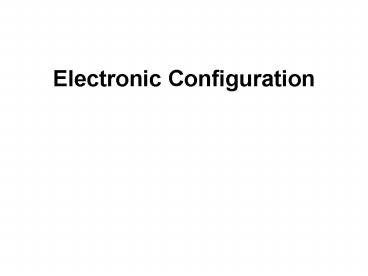Electronic Configuration - PowerPoint PPT Presentation
1 / 19
Title:
Electronic Configuration
Description:
Electronic Configuration Energy Levels Energy levels are called principal energy levels and are given numbers 1, 2, 3, 4, 5 These principal energy levels contain sub ... – PowerPoint PPT presentation
Number of Views:127
Avg rating:3.0/5.0
Title: Electronic Configuration
1
Electronic Configuration
2
Energy Levels
- Energy levels are called principal energy levels
and are given numbers 1, 2, 3, 4, 5 - These principal energy levels contain sub-levels
which are assigned the letters s, p, d
and f
3
4f
4d
4
4p
4s
Energy
3d
3p
3
3s
2p
2
2s
1
1s
4
Each type of sub-level can hold a different
number of electrons
Sub-level Maximum number of e-
s 2
p 6
d 10
f 14
5
4f14
4d10
4
4p6
4s2
Energy
3d10
3p6
3
3s2
2p6
2
2s2
1
1s2
6
Electron Orbitals
- Electrons are constantly moving, however,
orbitals are regions where is it highly likely an
electron might be found - The energy sub-levels are made up of orbitals,
each of which can hold a maximum of 2 e-.
7
Electron Orbitals
- The orbitals in different sub-levels have
different shapes
8
Each orbital can hold 2 e-.
The p sub-shell contains 6 e-
9
Each type of sub-level can hold a different
number of electrons
Sub-level Maximum number of e- Number of orbitals
s 2 1
p 6 3
d 10 5
f 14 7
10
Energy Levels
Orbital
4p
Energy
3d
4s
3p
3s
Sub- levels
2p
2s
Principal Energy levels
1s
11
Drawing Electron Configurations
- Electrons are drawn as single headed arrows.
- The direction of the arrows represent the spin of
the electron
12
Hunds Rule
- Electrons occupy orbitals as unpaired e-. The e-
are only paired when there are no more empty
orbitals available in that sub-level. This is
Hunds Rule - Paired electrons will have opposite spin as this
reduces the mutual repulsion between the paired
e-.
13
Energy Level Diagrams
4p
Energy
3d
4s
3p
3s
2p
2s
Na 11e-
1s2, 2s2, 2p6, 3s1
1s
14
Order of filling sub-shells
15
Energy Level Diagrams
4p
Energy
3d
4s
3p
3s
2p
2s
1s
16
Anomalous Electron Configurations
- Chromium has the electron configuration
- 1s2 2s2 2p6 3s2 3p6 3d5 4s1
- NOT 1s2 2s2 2p6 3s2 3p6 3d4 4s2
- The outer sub-level is half full, this is a more
stable arrangement.
17
Anomalous Electron Configurations
- Copper is
- 1s2 2s2 2p6 3s2 3p6 3d10 4s1
- NOT 1s2 2s2 2p6 3s2 3p6 3d9 4s2
- The outer sub-level is full, this is a more
stable arrangement.
18
Electronic Structure of Ions
- Positive Ions formed by the loss of e-
- Na Atom Naion
- 1s2 2s2 2p6 3s1 1s2 2s2 2p6
- Negative Ions formed by the gain of e-
- O Atom O2- ion
- 1s2 2s2 2p4 1s2 2s2 2p6
19
Structure of Transition Metal Ions
- With the transition metals it is the 4s electrons
are lost first when they form ions - Ti 1s2 2s2 2p63s2 3p6 3d24s2
- Ti2 1s2 2s2 2p63s2 3p6 3d2
- Cr 1s2 2s2 2p63s2 3p6 3d54s1
- Cr3 1s2 2s2 2p63s2 3p6 3d3































